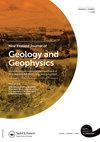Late Holocene earthquakes on the Papatea Fault and its role in past earthquake cycles, Marlborough, New Zealand
IF 1.9
4区 地球科学
Q1 GEOLOGY
New Zealand Journal of Geology and Geophysics
Pub Date : 2022-09-15
DOI:10.1080/00288306.2022.2117829
引用次数: 4
Abstract
ABSTRACT The north-striking sinistral reverse Papatea Fault ruptured with a very large (up to 12 m) oblique slip as part of the 2016 M W 7.8 Kaikōura earthquake in the northeastern South Island. Paleoseismic studies were undertaken at three sites along the Papatea Fault, named Murray’s roadcut, Jacqui’s Gully (both on the main strand), and Wharekiri trench (western strand). These sites provide evidence for up to three Late Holocene paleoearthquakes prior to 2016 (=E0) on this previously unmapped active fault, with preferred OxCal-modelled timings of 98–149 (E1), 546–645 cal yr BP (E2), and >738 cal yr BP (E3). Event correlations between the sites are generally consistent across these past events, implying that the two strands of the Papatea Fault link at depth and rupture together co-seismically as in 2016. Comparisons of its paleoseismic record with the Kekerengu Fault and uplift data from Waipapa Bay and Kaikōura, suggest that the Papatea Fault may have three distinct rupture modes: (i) Kaikōura-type multi-fault ruptures with multi-metre, anelastic block displacements and associated major landscape change; (ii) multi-fault earthquake ruptures with other regional fault combinations; and (iii) single-fault Papatea ruptures with metre-scale displacement. OxCal models offer the possibility that the E1 fault rupture occurred in 1855 CE.新西兰马尔堡,帕帕提亚断层上的晚全新世地震及其在过去地震旋回中的作用
摘要北向左旋逆断层Papatea断裂带破裂,形成一个非常大的(高达12 m) 2016年南岛东北部凯库拉7.8级地震的斜滑。在Papatea断层沿线的三个地点进行了古地震研究,分别命名为Murray’s路障、Jacqui’s Gully(均位于主干线上)和Wharekiri海沟(西线)。这些地点为2016年之前在该先前未绘制的活动断层上发生的多达三次全新世晚期古地震(=E0)提供了证据,OxCal模拟的时间优选为98–149(E1)、546–645卡-年BP(E2)和>738卡-年BP(E3)。在过去的这些事件中,这些地点之间的事件相关性通常是一致的,这意味着木瓜断层的两条线在深度上相连,并像2016年一样在同一地震中断裂。将其古地震记录与Kekerengu断层以及Waipapa湾和Kaikōura的隆起数据进行比较,表明Papatea断层可能具有三种不同的断裂模式:(i)Kaikßura型多断层断裂,具有数米的滞弹性块体位移和相关的主要景观变化;(ii)与其他区域断层组合的多断层地震破裂;和(iii)Papatea单断层断裂,位移为米级。OxCal模型提供了E1断层破裂发生在公元1855年的可能性。
本文章由计算机程序翻译,如有差异,请以英文原文为准。
求助全文
约1分钟内获得全文
求助全文
来源期刊
CiteScore
5.10
自引率
27.30%
发文量
34
审稿时长
>12 weeks
期刊介绍:
Aims: New Zealand is well respected for its growing research activity in the geosciences, particularly in circum-Pacific earth science. The New Zealand Journal of Geology and Geophysics plays an important role in disseminating field-based, experimental, and theoretical research to geoscientists with interests both within and beyond the circum-Pacific. Scope of submissions: The New Zealand Journal of Geology and Geophysics publishes original research papers, review papers, short communications and letters. We welcome submissions on all aspects of the earth sciences relevant to New Zealand, the Pacific Rim, and Antarctica. The subject matter includes geology, geophysics, physical geography and pedology.

 求助内容:
求助内容: 应助结果提醒方式:
应助结果提醒方式:


